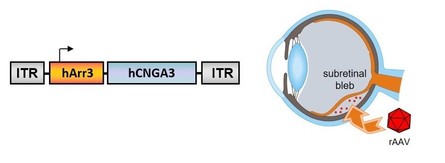Gene therapy
Gene therapies are technologies that use a gene to treat, prevent or cure a disease or medical disorder. Often, gene therapy works by replacing or editing a defective or missing gene in a patient’s cells with a healthy version of that gene. Both inherited genetic diseases and acquired disorders have been treated with gene therapy. Our laboratory has a long track record in using adeno-associated viral vectors (AAVs) to treat degenerative diseases of the retina that are linked to ion channel dysfuntion. We established gene therapies in mouse models for CNGA3-linked achromatopsia and CNGB1-linked retinitis pigmentosa, respectively. Building on these results a clinical trial for human CNGA3-linked achromatopsia has been successfully performed (Fischer et al. 2020).

Recombinant adeno-associated viral vector (rAAV8.hCNGA3) for expression of CNGA3 in human cone photoreceptors (see Fischer et al. 2020 and NCT02610582)
Our recent work aims at addressing current challenges in gene therapy. As an example, we are developing innovative mRNA trans-splicing approaches to overcome the gene size limitations of standard AAV technologies. Furthermore, we are developing CRISPR Cas-based technologies to allow in vivo transactivation and/or knockdown of (multiple) genes. Finally, we are extending our therapeutic portfolio to gene therapies for acquired disorders and diseases of the CNS and the cardiovascular system.
Transactivation of cone M-opsin in rod photoreceptors using dCas9-VPR (see Böhm et al. 2020)
Further reading
Riedmayr et al. (2020) Hum Mol Genet.
Fischer et al. (2020) JAMA Ophthalmol
Michalakis et al. (2014) Adv Exp Med Biol

